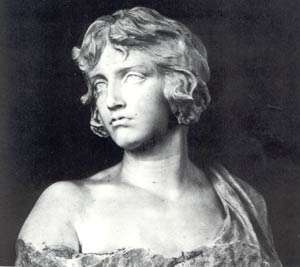Nossis
| Nossis | |
|---|---|
|
Nossis (marble bust by Francesco Jerace) | |
| Native name | Νοσσίς |
| Born | Epizephyrean Locris |
| Died | Epizephyrean Locris |
| Resting place | Unknown |
| Occupation | Poet |
| Language | Greek |
| Nationality | Roman peregrina |
| Ethnicity | Italiot Greek |
| Citizenship | Locrian |
| Years active | c. 300 BCE |
| Children | Melinno (presumed) |
Nossis (Greek: Νοσσίς) was a Hellenistic poet from Locri in southern Italy.[1] She primarily wrote epigrams for religious dedications and epitaphs.[2] Her epigrams were inspired by Sappho, whom she claims to rival.[3] She may have also been influenced by Erinna and Anyte.[4]
Nossis is one of the best preserved Greek women poets, with twelve epigrams attributed to her preserved as part of the Greek Anthology, the majority of which are about women.[5] One of these poems (preserved as A. P. 5.170) is modelled after Sappho's fragment 16.[6] Meleager of Gadara, in his Garland, includes her among the most distinguished Greek singers. Antipater of Thessalonica ranks her among the nine poets who deserved the honor to compete with the Muses.
Nossis states in her work that her mother was named Theuphila, the daughter of Cleouchas. In another epigram, she mentions that she had a daughter named Melinna,[7] who is possibly the poet Melinno.
References
- ↑ Barnard, Sylvia. "Hellenistic Women Poets". The Classical Journal, 73.3 (1978). p. 204.
- ↑ Bowman, Laurel. "The 'Women's Tradition' in Greek Poetry". Phoenix, 58.1 (2004). p. 16.
- ↑ Snyder, Jane McIntosh. The Women and the Lyre. (1991. Southern Illinois University Press, Carbondale). See Anthologia Graeca 7:718.
- ↑ Bowman, Laurel. "The 'Women's Tradition' in Greek Poetry". Phoenix, 58.1 (2004). p. 20.
- ↑ Barnard, Sylvia. "Hellenistic Women Poets". The Classical Journal, 73.3 (1978). p. 210.
- ↑ Barnard, Sylvia. "Hellenistic Women Poets". The Classical Journal, 73.3 (1978). p. 211.
- ↑ William Smith, Dictionary of Greek and Roman Biography and Mythology, London: Murray (1849), "Melinno"
Further reading
- Skinner, Marilyn B. "Aphrodite Garlanded: Erôs and Poetic Creativity in Sappho and Nossis". in Rabinowitz, Nancy Sorkin and Auranger, Lisa. Among Women: From the Homosocial to the Homoerotic in the Ancient World. University of Texas Press, Austin. 2002.
- Barra Bagnasco, M. 1990. “Nuovi documenti sul culto di Afrodite a Locri Epizefiri.” PP 45: 42–63.
- Barra Bagnasco, ed. 1992. Locri Epizefiri IV: Lo scavo di Marasà Sud. Il sacello tardo arcaico e la “casa dei leoni.” Florence.
- Barra Bagnasco. 1996. “Il culto extramuraneo di Afrodite.” In E. Lattanzi et al., eds. 27–29.
- Bowman, L. 1998. “Nossis, Sappho and Hellenistic Poetry.” Ramus 27.1: 39–59.
- Dillon, M. 2002. Girls and Women in Classical Greek Religion. London and New York.
- Gigante, M. 1974. “Nosside.” PP 29: 22–39.
- Gow, A. S. F., and D. L. Page, eds. 1965. The Greek Anthology: Hellenistic Epigrams. 2 vols. Cambridge.
- Gutzwiller, K. J. 1998. Poetic Garlands: Hellenistic Epigrams in Context. Berkeley, Los Angeles and London.
- Lattanzi, E., et al., eds. 1996. Santuari della Magna Grecia in Calabria. Naples.
- MacLachlan, B. C. 1995. “Love, War and the Goddess in Fifth-Century Locri.” AncW 26.2: 205–23.
- Prückner, H. 1968. Die lokrischen Tonreliefs. Mainz am Rhein.
- Redfield, J. M. 2003. The Locrian Maidens: Love and Death in Greek Italy. Princeton and Oxford: Princeton University Press.
- Skinner, M. B. 1989. “Sapphic Nossis.” Arethusa 22: 5–18.
- Skinner, M. B. 1991. “Nossis Thêlyglôssos: The Private Text and the Public Book.” In S. B. Pomeroy, ed., Women’s History and Ancient History. Chapel Hill and London: 20–47.
- Skinner, M. B. 2001. “Ladies’ Day at the Art Institute: Theocritus, Herodas, and the Gendered Gaze.” In A. Lardinois and L. McClure, eds., Making Silence Speak: Women’s Voices in Greek Literature and Society. Princeton, N.J., 201–22.
- Sourvinou-Inwood, C. 1978. “Persephone and Aphrodite at Locri: A Model for Personality Definitions in Greek Religion.” JHS 98: 101–21.
External links
-
 Greek Wikisource has original text related to this article: Νοσσίς
Greek Wikisource has original text related to this article: Νοσσίς - Text of her 12 surviving epigrams
